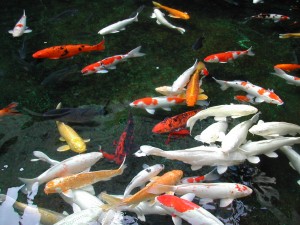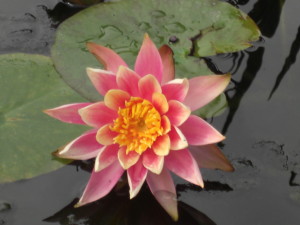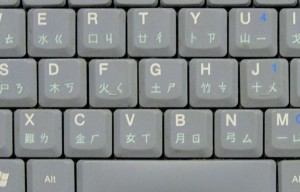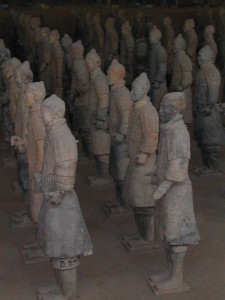Transliterating Chinese
There are two major modern methods of representing the sounds of the Chinese language phonetically for use by foreign students of the language:
1. the Chinese National Phonetic Alphabet (abbreviated ‘CNPA’, and usually called ‘Bopomofo’ after the first four element-sounds.) In Chinese it is called ‘Zhù Yin Fú Hào’ [注音符號/注音符号] pron.: joo4 in foo2 how4 (promulgated in 1928 by the Republic of China, and presently used in Taiwan.)
2. Pinyin Romanization (Called Hànyǔ Pīnyīn, promulgated by the PRC in 1958 and used in China and world-wide.)
CNPA/Bopomofo
CNPA was the first Chinese attempt at phonetic transliteration of the language, created after the fall of the Qīng (pron.: Chīng) Dynasty. It contains 37 relatively simple phonetic ‘elements’ that could be likened to letters in Latin languages, even though they are distinctly Chinese in shape.
Because the first elements in this series are ‘be’ [ㄅ], ‘pe’ [ㄆ], ‘me’ [ㄇ] and ‘fe’ [ㄈ], this system is often called ‘Bopomofo’ by students (pron.: bow, poe, moe, foe). The word ‘Bopomofo’ is used in the same way that ‘abc’ is used in English as a word-substitute for the word ‘alphabet’.
Bopomofo elements are written in sequential groups of 2 or 3 elements just like Latin letters in words, but since Chinese words are relatively simple in their sound combinations, 2 or 3 Bopomofo elements are all that are required to phonetically represent a single character’s pronunciation.
Note that Chinese language sounds are divided into 2 classes:
- Initial sounds are sounds that are used at the beginning of Chinese words.
- Final sounds are, obviously, those used at the end of Chinese words.
As should be expected, this rule does have exceptions: some of the Finals are, in fact, also used as the beginning sounds of some words.
The following are the Bopomofo elements (in their ‘natural’ or ‘alphabetical’ (sic) order reading from top to bottom, beginning at the left) and their Pinyin equivalents:
| CNPA/Bopomofo Symbols | |||
| Initial Sounds | Final Sounds | ||
| ㄅ – be | ㄐ – ji | ㄚ – a | ㄥ – eng |
| ㄆ – pe | ㄑ – qi | ㄛ – o | ㄦ – er |
| ㄇ – me | ㄒ – xi | ㄜ – e | 一 – yi |
| ㄈ – fe | ㄓ – zhi | ㄝ – eh | ㄨ – wu |
| ㄉ – de | ㄔ – chi | ㄞ – ai | ㄩ – yü |
| ㄊ – te | ㄕ – shi | ㄟ – ei | |
| ㄋ – ne | ㄖ – ri | ㄠ – ao | |
| ㄌ – le | ㄗ – zi | ㄡ – ou | |
| ㄍ – ge | ㄘ – ci | ㄢ – an | |
| ㄎ – ke | ㄙ – si | ㄣ – en | |
| ㄏ – he | ㄤ – ang | ||
[Note that the pronunciations of the above symbols are not necessarily the same as the English pronunciation of the Pinyin letter representations shown above. See below for a complete listing of the actual pronunciations of these symbols. For a complete listing of the pronunciation of the 402 Chinese word-sounds, see Appendix A. For a description of the articulation of Chinese sounds, see the explanation in the section below entitled “Pinyin Romanization Tokens”.]
 A view overlooking Hong Kong harbor from Victoria Peak.
A view overlooking Hong Kong harbor from Victoria Peak.
Pinyin and Other Romanization Systems
Pinyin is the newest Romanized transliteration system. It was promulgated in the People’s Republic of China (PRC) in 1958 and has become the most pervasive system used in the world to transliterate Chinese. It is even used in China to teach school-children Chinese! In Chinese, ‘pīnyīn’ (拼音) means ‘to phoneticize’ (in Chinese, literally, ‘to spell the sound’). It has replaced the many other earlier Romanization systems that attempted to provide phonetic transliterations of Chinese language sounds.
The original, widely-used Romanized transliteration system developed in the 19th century was the Wade-Giles System. It had some substantial flaws in its transliterations that tended to confuse non-Chinese speakers as to the actual sounds of the language. Unfortunately, because any Romanization system is an attempt to use ‘foreign’ sounds and their phonetic symbols (ie. Latin/Roman letters), to represent Chinese language sounds, they also create and perpetuate problems in representing those same Chinese sounds.
This is because the Chinese language contains sounds that don’t exist in English (and some other languages), and therefore all Romanization systems have to use some letters and letter-combinations as tokens to indicate these uniquely Chinese sounds, which are not the usual or expected pronunciations of the tokenized letters and letter-combinations.
These problems gave rise to a number of other Romanization attempts in the 20th century (notably the Yale, Harvard and Guóyǔ Romatzi systems). Because these systems also have their own flaws, the newer Chinese Pinyin system is preferable, particularly since as a standardized system Pinyin has the ‘weight’ of the PRC behind it.
Pinyin is better because for the most part, it uses the ‘native’ English pronunciations for most letters and letter-combinations. There are still, however, some letters and letter-combinations that are used as tokens with non-English (ie. Chinese) sounds.
For the student, the actual pronunciation of these tokens must be mastered for Pinyin to be used effectively.
 A ‘splash’ of color: Chinese carp swimming in a pool.
A ‘splash’ of color: Chinese carp swimming in a pool.
Pinyin Romanization Tokens
The Latin tokens of Initial sounds meant to have Chinese sounds when transliterated using Pinyin are: c, r, q, qi, x, xi, z*, and zh*
*Note that the ‘z‘ and ‘zh‘ tokens do not represent similar or even related Chinese sounds, even though both tokens use the Latin ‘z’.
In addition, for both of these tokens, the ‘z’ does not represent the English language ‘z’-sound. There is no phonetically English ‘z’-sound in the Chinese language, and Chinese speakers have a very difficult time learning to pronounce the English ‘z’-sound correctly.
Similarly, there is no phonetically English ‘zh’-sound in the Chinese language, and Chinese speakers can’t easily pronounce this English sound either.
Articulation of Chinese Sounds
These sounds are articulated substantially differently than these sounds would be when used in English or Romance languages. These sounds are produced with the tip of the tongue rolled back in the mouth and almost (but not quite,) touching the soft palate, leaving a small space for air to pass through, and which produces a slight sibilance or hissing sound.
The Chinese sounds for these Initial tokens are:
c = a highly asperated ‘ts’ sound, almost a ‘tssss’ (There is no English equivalent sound.)
q = ‘ch’ (as in ‘Chinese’) and qi = ‘chee’
x = ‘sh’ and xi = ‘shee’
z = ‘dz’, like the sound in the word ‘adze’ (There is no English equivalent sound.)
zh = a kind of a ‘j’-sound (actually, exactly like the ‘g’-sounds in the name ‘George’,) articulated with the tongue curled up and back, and the tip almost touching the soft palate producing a vibration or sibilance. (There is no English equivalent sound.)
The Latin tokens of the Final sounds are:
a, o, e, eh, ai, ei, ao, ou, an, en, ang, eng, er, yi, wu and yü
The Chinese sounds for these Final tokens are:
| Finals Chinese Pronunciation | ||||
| Final Sounds Tokens: Pinyin | CNPA | Pronunciation | Similar sound | Comment |
| a | ㄚ | ‘ah’ | the ‘a’ sound in ‘mama’ | when used in transliterations like ‘ba,’ ‘pa,’ ‘ma,’ ‘ta’ |
| o | ㄛ | ‘awe’ | the ‘aw’ sound in ‘awful’ | when used in transliterations like ‘bo,’ ‘po,’ ‘mo,’ ‘fo’ |
| e | ㄜ | ‘e’ | all rhyme with the French words ‘de’ and ‘le’ | when used in transliterations like ‘de’, ‘te,’ ‘ne,’ ‘ke,’ ‘le’ |
| eh | ㄝ | ‘eh’ | sounds like the ‘e’-sound in ‘pet’ | |
| ai | ㄞ | ‘aye’ | sounds like the ‘i’-sound in ‘China’ | |
| ei | ㄟ | ‘ae’: the English hard-‘a’ sound [ā] | rhymes with ‘may’ | |
| ao | ㄠ | ‘ao’ | rhymes with ‘how’ | |
| ou | ㄡ | ‘oh’: the English hard-‘o’ sound [ō] | rhymes with ‘go’ | |
| an | ㄢ | ‘ahn’ | Like the ‘an’ sound in the name ‘Anya’ | |
| en | ㄣ | ‘un’ | rhymes with ‘fun’ | |
| ang | ㄤ | ‘ahng’ | rhymes with ‘pong’ | |
| eng | ㄥ | ‘ung’ | rhymes with ‘hung’ | |
| er | ㄦ | ‘are’ | like the English pron. of the letter ‘r’ | regional pron. in S. China and TW is the Eng. style pron. of ‘er’ |
| yi | 一 | ‘ee’ | the ‘y’ is silent | |
| wu | ㄨ | ‘oo’ | the ‘w’ is silent | |
| yü | ㄩ | Exactly the same as the German ümlaut-U [ü] sound. The ‘y’ is silent. | This sound does not exist in English. | |
Common Name Mispronunciations By Those Unfamiliar With Pinyin Transliteration Tokens
The name most mispronounced by non-speakers of Chinese is the name of China’s capital — Běijīng. You hear newscasters mispronounce this name constantly (and we expect them to know better, don’t we?)
Běijīng is NOT pronounced phonetically ‘BeiZHing’. This pronunciation is just obtuse. The correct pronunciation is simply Běijīng, pronounced exactly as it is spelled (with a ‘j’ sound), and it means ‘Northern capital’. (Just FYI, in Chinese, Tokyo, Japan is called ‘Dōngjīng’ [which means ‘Eastern capital’] and Nánjīng [in Jiāngsū province] means ‘Southern capital’ […there is no ‘Western capital’].)
Guangzhou is NOT pronounced phonetically ‘GuangZHou’. The ‘zh’ letter-combination here is a token for a sound like the ‘g’-sounds in ‘George’ (and for descriptive clarity could be transliterated simply as ‘j’ (see the appendix for a more detailed pronunciation guide to indicate the ‘j’-like sound of the ‘zh’ Pinyinization, and its special articulation). Thus, ‘zhou’ is pronounced ‘joe’, and Guǎngzhōu is pronounced ‘Guangjoe’. Similarly, Hángzhōu is pronounced ‘Hangjoe’, Fúzhōu is pronounced ‘Fujoe’, Lánzhōu is pronounced ‘Lanjoe’ and Sūzhōu is pronounced ‘Sujoe’.
Shanghai is NOT pronounced Shang (rhymes with ‘bang’)-hai, it is pronounced ‘Sh +ahng + hai’. ‘Shang’ rhymes with ‘pong’ (as in ‘ping pong’).
Problems Using Romanization Systems
Foreigners who use Romanization systems like Pinyin as a way to learn Chinese pronunciation occasionally suffer from some particular pronunciation problems. As can be seen from the section above, it is easy to make pronunciation mistakes using Pinyin Romanizations, if you don’t know or forget the special Chinese pronunciations of the Pinyin tokens.
 A beautiful lotus flower floating in a pool.
A beautiful lotus flower floating in a pool.
No matter how well some students study the intended Chinese sounds of the Romanized tokens, there remains a tendency to fall back on the original, native-language (English, French, Italian, etc.) pronunciations of the tokenized Latin letters or letter-combinations, especially when reading books using Pinyin transliterations as an aid to pronouncing the characters.
This can result in the student sometimes using strange pronunciations for Chinese words: speaking with what might be called a ‘Pinyin’ accent, rather than using the ‘standard’ Chinese pronunciation of words. (In fact, there is a ‘Standard Chinese’ pronunciation- which paradoxically, most Chinese don’t use …but more on that later.)
For this reason, in this writer’s opinion, the only phonetic system that clearly and accurately represents the spoken sounds of Chinese to Western-language speaking students of Chinese is the CNPA/Bopomofo system (which is no longer used in China, and is only now used in Táiwān).
This is because each Bopomofo phonetic symbol represents a distinct Chinese sound which, to foreigners, has no other sound-association. Thus, students of Chinese who use the Bopomofo system to learn the sounds of the Chinese language don’t have a pronunciation confusion with the Chinese sounds because there are no Latin-letter associations.
Using the CNPA symbols as pronunciation models requires ‘Standard Chinese’ pronunciation because Bopomofo transliterations exactly describe the Standard Chinese pronunciation.
So, if you study Chinese in Táiwān and have a choice of using either Pinyin or Bopomofo as the transliteration system, choose Bopomofo and your pronunciation will benefit (…and you can always learn Pinyin on your own, later: once you know Bopomofo, learning Pinyin is easy.) Bopomofo is usually learned in the first week of study in Táiwān and is a matter of a few hours of reading, listening and practicing the pronunciation of the sounds as you learn the symbols. Proficiency comes with use and repetition.
Problems Using Bopomofo
Unfortunately, Bopomofo is used only in Táiwān, and has not been generally used in China since 1958. Because of this, the only place that you can find textbooks and other learning materials that use Bopomofo is in Táiwān.
Most young Chinese are unfamiliar with the CNPA elements, and only use Pinyin. Older Chinese now in their 80s and 90s remember Bopomofo because it was used in all Chinese schools prior to the late 1950s, when the Chinese government promulgated the Pinyin Romanization System. (It should be noted here as well, that Taiwanese are generally unfamiliar with Pinyin, as they do not use it.)
There is another difficulty regarding the use of Bopomofo, and that is that (in the past,) typewriters did not contain the Bopomofo phonetic elements, and on computers today they are not easily accessible: you must use an IME (Input Method Editor).
The IME enables the entry of foreign-language characters on ‘ABC’ keyboards. All Chinese use an IME to enter Chinese characters into their computers, even computers with a Chinese Windows or other Chinese-language operating system. IMEs for Simplified or Traditional Chinese characters are available as a free download from microsoft.com for Microsoft Windows English-language computers and for Microsoft Office XP and later versions.
Apple’s operating systems also contain Chinese characters with an IME. Note that some word processors (like Adobe) also require the download and installation of Chinese Fonts for display and/or printing use.
 A computer keyboard modified with key overlays enabling input using a Bopomofo IME.
A computer keyboard modified with key overlays enabling input using a Bopomofo IME.
If you want to use Bopomofo, you must use an IME on your computer and you must have your computer’s keyboard modified with identifying characters on the keys, or use a plastic overlay so that you can determine what keys to use to enter the Bopomofo elements.
See the enlarged picture of a Chinese-language modified keyboard (on the left): note that on this keyboard, the Bopomofo elements have been added to the lower right corner of the keys. (In the picture, the Chinese characters on the lower left of the keys are for use with a different entry-system popular among Taiwanese, called ‘Cāng jié’ [pron.: tsāng jié] that uses the Kangxi radicals as the basis of the entry-system.)
As a practical matter, outside of Táiwān, we are left with the use of Pinyin by default: most American university Chinese courses, for instance, use Pinyin as the teaching method. Similarly, it is used throughout Europe as the teaching method.
However, Chinese characters can also be entered into a computer using the IME with Pinyin as the entry method instead of Bopomofo*: this requires no modification of the keyboard and is the usual method used by Chinese, as well as by foreign students of the language studying both inside and outside China.
*Note that when using Pinyin as the input method with the IME, the sound pinyinized as ‘ü’ is entered using the ‘v’ key and not, as you might expect, the ‘u’ key (which is used for the other Chinese ‘u’-sound pinyinized as ‘wu’).
As the influence of China is now felt worldwide, and the Chinese government encourages the study of Chinese with direct and indirect subsidies and financial incentives everywhere, study using Pinyin as the transliteration system presents no problem. Pinyin learning materials are available all over the world and all foreign students have the opportunity to use Pinyin-based texts in their own localities. A simple perusal of Amazon will indicate that Pinyin learning texts are easily available.
Pinyin Use in China
Interestingly, China has been using their Romanized Pinyin system to teach characters to Chinese children since its promulgation in 1958.
Because Chinese is a ‘native’ language to them (sic), and also because young Chinese students have no pre-existing understanding of the ‘native’ sounds of the tokenized Pinyin Roman letter combinations, Chinese children don’t have the problem of speaking ‘Pinyinized’ Chinese.
Native-language Chinese students suffer from other pronunciation problems instead, but, no matter …it is, of course, their language.
Pronunciation of Chinese Sounds
Native speakers of a language are not usually aware of how easy or difficult the creation of the sounds of their language are. This is because as children, we all naturally learn how to pronounce the sounds of our native language. Language and the learning of language is clearly an innate talent of the young of the human species.
Some languages have sounds that don’t exist in other languages, which is one of the things that sometimes makes it difficult for people to learn the pronunciation of foreign language sounds.
 Qín dynasty army of terra cotta warriors in Xi’an that accompanied the emperor in the afterlife.
Qín dynasty army of terra cotta warriors in Xi’an that accompanied the emperor in the afterlife.
This is so particularly after reaching adulthood, when the sounds of one’s native language are ‘hardwired’ into one’s experience, and when the ability to naturally reproduce the sounds one hears in foreign languages has been lost (for at least some, if not most of us).
This creates difficulty in pronouncing the sounds of foreign languages, particularly if the sounds of the foreign language require articulations of the mouth, tongue and/or lips that are unfamiliar or unused in one’s native language. The result is that most speakers of foreign languages speak with accents characteristic of their native languages.
A good example of this are the ‘th’ sounds of English, which require that the tongue be place between the upper and lower front teeth.
German has no similar sound, nor do German native-speakers ever place their tongue between their teeth to make a comparable sound. So when German speakers learn English, they often fall back on the closest familiar articulation that they can easily pronounce …which leads many of them to say ‘zay’ instead of ‘they’ until they master the correct articulation of the ‘th’ sound.
Similarly, Chinese has some sounds that require substantially different articulation of the tongue than native English speakers are used to. The primary example of this is an Initial sound that in Pinyin is transliterated with an ‘r’. (In the older Wade-Giles System it was transliterated with a ‘j’ instead of an ‘r’.)
This Chinese ‘r’ sound is not the same as the ‘r’ sound of English, because it is not created with the same articulation as the English ‘r’ sound. Many English speakers unfortunately end up using the English articulation when making the Chinese ‘r’ sound …resulting in a characteristic English-speaker’s accent in Chinese.
Instead of the familiar ‘r’ articulation of English, the Chinese ‘r’ sound is made with the tongue rolled back in the mouth, with the tip of the tongue almost touching the roof of the mouth about halfway back to the soft palate, thus partially blocking the airflow in the mouth, and producing a slight sibilance of the tongue as an addition to the ‘r’ sound …a very different articulation and result then native English speakers are used to.
The resultant Chinese sound has some characteristics of an ‘r’ sound, but also has some overtones of a ‘j’ sound as well: this sound is transliterated in Pinyin as ‘ri’.
This ‘Chinese articulation’ of the tongue, rolled back in the mouth with the tip almost touching the roof of the mouth, is present in other sounds of the Chinese language and gives Chinese a characteristic sound.
It is also used in pronouncing all words transliterated with a ‘zh’, such as the ‘zhi’ and ‘zhe’ transliterations (among others [see Appendix A for a full list], all with clearly ‘j’-like sounds,) as well as the ‘shi’ and ‘chi’ transliterations (neither of which has any trace of a ‘j’-sound.)
Mastering this articulation is a must for the student of the language who wishes to speak clear and easily understood Standard Chinese.
Home Back Top of Page Next Page
© R. Teller, 2015

